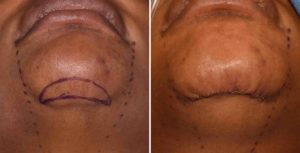The chin is the projecting feature of the lower face and consists of combined bone and soft tissue. While the chin may be more commonly recognized for treatment of deficiencies in its size and projection, it is also prone to the opposite issues of excess and sagging. Chin bony overgrowths (hyperplasia), chin pad sagging (ptosis) and hyperdynamic chin pad protrusions are all a collection of aesthetic chin prominences.
Unlike augmenting the chin with an implant or moving the bone which can be done in an intraoral scarless manner, decreasing the size of the chin can rarely be so done. By definition most chin excesses are a combination of bone and soft tissue which must be both addressed for an effective aesthetic change. This eliminates the use of an intraoral approach in many cases as this access provides no method for soft tissue removal or tightening. The intraoral approach can be used to try and lift up the sagging chin pad in some cases of ptosis but this has very variable amounts of success.
When using a submental approach for chin reduction, the key is the location and length of the scar. The incision and resultant scar must be placed far enough back under the chin so it does one end up on the visible anterior edge of the chin. But the length of the scar is also of critical importance to limit its potential visibility. When removing redundant soft tissues (submental excision and tuck), it is easy to end up chasing redundancies at the end of the incisional closure and have a longer scar that one may have initially anticipated. If the scar becomes too long or curves up at the ends it may become visible from the side.

Dr. Barry Eppley
Indianapolis, Indiana


